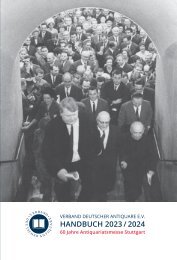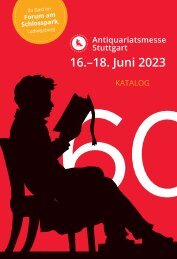Antiquariatsmesse Stuttgart 2021 - Katalog
Katalog zur Antiquariatsmesse Stuttgart 2021: Die Antiquariatsmesse Stuttgart als größtes Schaufenster für wertvolle Objekte des Antiquariats- und Graphikhandels in Deutschland findet in diesem Jahr in ungewohnter Form statt. Da eine Präsenzmesse nicht stattfinden kann, haben sich 76 Kollegen aus Deutschland, Großbritannien, Österreich, Frankreich, der Schweiz, den Niederlanden, den Vereinigten Staaten und aus Australien zusammengefunden, um einen Katalog für die Messe zu erstellen und gleichzeitig ein Angebot für eine virtuelle Messe zusammengetragen. Der Katalog wird am 7. Januar 2021 an interessierte Kunden verschickt, die virtuelle Messe öffnet ihre „digitalen Pforten“ am 29. Januar 2021 um 12.00 Uhr unter www.antiquariatsmesse-stuttgart.de
Katalog zur Antiquariatsmesse Stuttgart 2021: Die Antiquariatsmesse Stuttgart als größtes Schaufenster für wertvolle Objekte des Antiquariats- und Graphikhandels in Deutschland findet in diesem Jahr in ungewohnter Form statt. Da eine Präsenzmesse nicht stattfinden kann, haben sich 76 Kollegen aus Deutschland, Großbritannien, Österreich, Frankreich, der Schweiz, den Niederlanden, den Vereinigten Staaten und aus Australien zusammengefunden, um einen Katalog für die Messe zu erstellen und gleichzeitig ein Angebot für eine virtuelle Messe zusammengetragen.
Der Katalog wird am 7. Januar 2021 an interessierte Kunden verschickt, die virtuelle Messe öffnet ihre „digitalen Pforten“ am 29. Januar 2021 um 12.00 Uhr unter www.antiquariatsmesse-stuttgart.de
Erfolgreiche ePaper selbst erstellen
Machen Sie aus Ihren PDF Publikationen ein blätterbares Flipbook mit unserer einzigartigen Google optimierten e-Paper Software.
Antiquariaat Junk
Allard Schierenberg
Van Eeghenstraat 129 · 1071 GA Amsterdam, Niederlande
Telefon +31 20 676 31 85 · Fax +31 20 675 14 66
E-Mail: books@antiquariaatjunk.com · Internet: www.antiquariaatjunk.com
Alte Naturwissenschaften · Reisen
Andrews, H. C. Coloured Engravings of Heaths.
The drawings taken from living plants only. With the
appropriate specific character, full description, native
place of growth, and time of flowering of each;
in Latin and English. Each figure accompanied by
accurate dissections of the several parts (magnified
where necessary) upon which the specific distinction
has been founded, according to the Linnaean
System. London, T. Bensley [vol I], R. Taylor [vols
II-IV] for the Author, [1794–] 1802–1809 [–1830].
4 vols bound in two. Folio (423 × 259 mm). With
engraved dedication leaf and 288 hand-coloured
engraved plates; vol III without half-title, some
occasional minor spotting to prelims and a few text
leaves, a fine, clean copy in contemporary speckled
calf by J. Clarke, rebacked preserving original
spines, gilt edges. € 45000,–
First edition, with the rare fourth volume, of Andrews’
‚finest achievement … noble in conception
and impressive in execution‘ (Blunt). Andrews drew
and engraved all his plates, wrote most of the text and,
according to Dunthorne, even did his own colouring.
This work exemplifies the ‚erica-mania‘ that dominated
English horticulture at the beginning of the nineteenth
century. Numerous newly discovered South African
species were being introduced through the enterprise of
nurserymen like Lee and Kennedy, and several hundred
species and varieties were available and in cultivation.
This copy contains all the indexes, dedication, address,
introduction, dissertation, list of heaths cultivated by
Lee and Kennedy at the Vineyard Nursery in Hammersmith,
systematical arrangements, etc. In common
with other copies seen, the titlepage of volume IV is in
fact the title from volume II with the number altered by
hand. The work was published in parts, and volume IV
appeared over a twenty-year period from 1810 to 1830.
Few complete copies survive, and most sets comprise
only the first three volumes, with occasionally a fragment
of the fourth.
Dunthorne 9; Great flower books, p 47; Johnston 674
(vols I-III only); Nissen BBI, 31; Stafleu and Cowan
134.
Baer, K. E. von. Über Entwicklungsgeschichte
der Thiere. Beobachtung und Reflexion. Königsberg,
Gebrüder Bornträger, 1828. 2 volumes. 4to
(243 × 215 mm). pp. xxii, (2, Verbesserungen), 271,
(1); (4), 315, (1), with 1 fold. table and 7 (4 handcoloured)
engraved plates and a few diagrams in the
text. Contemporary marbled boards. € 5000,–
First edition of the ‚foundation treatise on the embryology
of the higher animals‘ (Horblit 9a). „Continuing
the work of his friend and collaborator Christian
Heinrich Pander (to whom the ‚Über Entwicklungsgeschichte
der Thiere‘ is dedicated), Baer observed
the formation of the germ layers and established the
germ layer theory. He described the way in which
the layers formed various organs by tubulation, and
he emphasized that the development of the embryo
is from the apparently homogeneous to the obviously
heterogeneous. In this he finally refuted the long held
and much discussed theory that embryonic parts might
be preformed in the egg. The publication of this book
provided a solid basis for the further systematic study
of the mammalian development“ (Grolier ‚Medicine‘
p. 215). Without the supplement to volume 2 published
after Baer’s death in 1888 by Ludwig Stieda. Some occasional
minor foxing.
Provenance: Old stamp of Dr. Jules Barrois, Lille on
titles and 2 other leaves. PMM 288b, Norman 101;
Horblit 9a.
128






